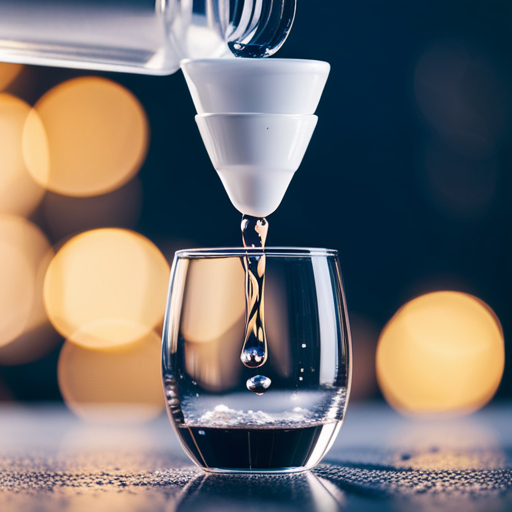Are you tired of drinking water that tastes like salt? Excess sodium in drinking water can have harmful effects on your health. But don’t worry, there’s a solution: reverse osmosis technology.
Reverse osmosis has become the go-to method for removing salt from drinking water. It’s a process that uses a semi-permeable membrane to filter out impurities, including salt. With reverse osmosis, you can say goodbye to the unpleasant taste and health risks associated with high levels of sodium in your drinking water.
In this article, we’ll explore how reverse osmosis works, its benefits and drawbacks, and other technologies available for salt removal. So, get ready to learn how to say goodbye to salt in water with reverse osmosis.
Key Takeaways
– Reverse osmosis (RO) can remove salt from drinking water with a typical residential system removing 99% or more of salt.
– RO works by forcing water through a semi-permeable membrane and can remove other contaminants, making it a benchmark technology for salt reduction.
– Other technologies for salt removal include distillation systems, electrodialysis, salt-free water softeners, and carbon filters, each with their own pros and cons.
– Combining an RO system with a salt-free water softener can remove residual salt and provide extra protection for those on restricted sodium diets.
Salt in Drinking Water
You already know that too much salt in drinking water can be harmful. The effects of high sodium intake can lead to health risks of consuming salt in excess, including high blood pressure, heart disease, and stroke.
While sodium is present in almost all drinking water, it is important to maintain a healthy balance to avoid these negative effects. Reverse osmosis is a benchmark technology for removing salt in drinking water. Typical residential systems remove 99% or more of salt using a semi-permeable membrane.
This technology provides extra protection for those on a restricted sodium diet and helps ensure that your drinking water is safe and healthy.
Reverse Osmosis Technology
By using a semi-permeable membrane, reverse osmosis technology forces water through it to remove contaminants and ensure your drinking water is safe and pure. This technology is highly effective in removing salt from your drinking water, with typical residential systems removing 99% or more of salt.
Compared to other technologies, such as distillation systems and electrodialysis, reverse osmosis is the benchmark technology for salt reduction.
To keep your reverse osmosis system functioning at its best, regular maintenance is required. This includes replacing filters and membranes as needed, as well as disinfecting the system to prevent bacterial growth.
Despite the maintenance requirements, the effectiveness of reverse osmosis in removing salt and other contaminants makes it a popular choice for those looking to ensure the purity of their drinking water.
Alternative Salt-Removal Methods
If you’re looking for alternative methods of removing salt from your drinking water, there are other technologies available besides reverse osmosis. Two other methods include distillation and electrodialysis.
Distillation systems use heat to boil the water and collect the condensed steam, which is then pure water. This process removes almost all impurities, including salt.
Electrodialysis uses an electric current to remove salt from the water, allowing only pure water to pass through.
Another alternative to salt removal is using salt-free water softeners. These systems use different technologies, such as magnetic or ion exchange, to remove hardness from the water without adding salt.
By removing hardness, the water becomes less likely to cause scale build-up in pipes and appliances. Salt-free water softeners can also be combined with a reverse osmosis system to remove residual salt and provide a more complete solution to salt removal.
Conclusion
Congratulations! You now know all about salt in drinking water and how reverse osmosis can help remove it. With its high efficiency in salt reduction, RO has become the go-to technology for many households and industries.
However, it’s important to note that RO also has its drawbacks, such as high maintenance costs and the production of wastewater.
Fortunately, there are also alternative salt-removal methods available, such as distillation and ion exchange. If you’re considering investing in a salt-removal system, be sure to weigh the benefits and drawbacks of each technology and choose the one that best fits your needs and budget.
With the right system, you can say goodbye to excess salt in your drinking water and enjoy a healthier, safer lifestyle.




